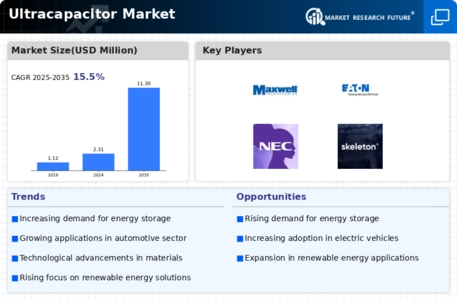Top Industry Leaders in the Ultracapacitor Market

The Competitive Landscape of the Ultracapacitor Market
Ultracapacitors, those remarkable energy storage devices bridging the gap between batteries and traditional capacitors, are experiencing a surge in popularity. Their ability to deliver rapid bursts of power, tolerate numerous charge-discharge cycles, and operate in extreme temperatures makes them ideal for diverse applications from electric vehicles and renewable energy systems to industrial machinery and medical devices. To navigate this dynamic market, understanding the competitive landscape, adopted strategies, key players, and emerging trends is crucial for both established and aspiring participants.
Some of the Ultracapacitor companies listed below:
- Maxwell Technologies
- Nippon Chemi-Con Corporation
- Eaton
- LS MTRON LTD
- Ness Capacitor Co., Ltd.
- NEC Corporation
- Skeleton Technologies
- KEMET Corporation (YAGEO Group)
- Panasonic Corporation
Strategies Adopted by Leaders:
- Embracing Innovation and Cutting-Edge Technologies: Investing in R&D to integrate advancements like high-performance electrode materials, improved separator technologies, and innovative cell designs differentiates solutions and caters to the need for higher energy density, faster charging, and extended cycle life.
- Prioritizing User Experience and Technical Support: Providing detailed technical specifications, application notes, and readily available technical support ensures users leverage the full potential of the ultracapacitors and fosters ongoing customer satisfaction.
- Partnerships and Ecosystem Building: Collaborating with component suppliers, electronics manufacturers, system integrators, and research institutions expands knowledge base, opens new markets, and facilitates broader adoption of ultracapacitor solutions.
- Focus on Safety and Sustainability: Implementing stringent safety protocols, achieving environmental certifications, and employing sustainable manufacturing practices build trust and cater to customers with growing environmental awareness.
- Cost-Effectiveness and Manufacturing Efficiency: Streamlining production processes, minimizing material waste, and offering competitive pricing enable affordability and penetration into cost-sensitive market segments.
Factors for Market Share Analysis:
- Product Portfolio and Technological Breadth: The range and sophistication of ultracapacitors offered, encompassing diverse types like cylindrical, prismatic, and pouch cells, with variations in capacitance, voltage, temperature range, and cycle life, significantly impact market reach. Catering to specific applications, such as regenerative braking systems or power backup for critical infrastructure, requires tailored solutions and partnerships.
- Target Market Focus: Focusing on specific segments within the technology ecosystem, such as automotive manufacturers, renewable energy developers, industrial automation companies, consumer electronics companies, or medical device manufacturers, requires customized marketing strategies and technical specifications addressing their unique needs. Solidifying market share hinges on understanding these sector-specific concerns.
- Performance and Efficiency: Balancing high capacitance, rapid charging and discharging capabilities, and energy density with operational efficiency in terms of energy loss and self-discharge are crucial for optimizing performance across diverse applications.
- Safety and Reliability: Implementing robust safety features, achieving industry certifications, and demonstrating long-term operational reliability are paramount for building trust and ensuring safe integration into sensitive systems.
- Cost and Scalability: Offering cost-competitive solutions, providing scalable manufacturing capabilities, and minimizing environmental impact throughout the manufacturing lifecycle cater to customers with growing economic and environmental concerns.
New and Emerging Companies:
- Niche-Focused Specialists: Companies like Ioxus and Nesscap specialize in developing high-performance, ruggedized ultracapacitors for extreme environments and demanding applications like aerospace, military equipment, and medical implants, offering unparalleled expertise and tailored solutions.
- Graphene-Based Technologies: Companies like Vorta Energy and Nanoxergy focus on developing next-generation ultracapacitors with graphene electrodes, promising significant improvements in energy density, charging speed, and cycle life.
- Open-Source Hardware Advocates: Companies like OpenCap and Hackaday promote open-source ultracapacitor designs and readily available fabrication instructions, empowering researchers and DIY enthusiasts with customization options and fostering innovation within the community.
Latest Company Updates:
Nov. 08, 2023, LS Materials, an LS Cable & System subsidiary, announced that it would supply ultracapacitors (UC), considered the next-generation secondary batteries, to a Japanese AGVs manufacturer. The Japanese company will install LS Materials' ultracapacitors on its AGVs to be charged in real-time during operation for component transportation in clean rooms and supply these to semiconductor factories in Taiwan.
Oct. 16, 2023, Florrent announced raising $2.1 MN to produce bio-derived ultracapacitor-activated carbon. The catalytic capital will enable Florrent to begin outfitting their pilot manufacturing facility to scale up the production of their next-generation ultracapacitor-activated carbon material. The company will also invest in critical R&D equipment from these funds and build its team of scientists, engineers, and professionals.
Oct. 03, 2023, Abracon, a leading provider of frequency control, timing, power, magnetics, RF, and antenna solutions, launched an all-new line of 2.7V & 3.0V EDLC radial supercapacitors. These ultracapacitors can revolutionize energy supply and storage with their unmatched performance, reliability, and versatility.
Abracon's new line of ultracapacitors has been designed and engineered to address the ever-growing demands for high-capacity, fast-charging energy storage solutions across industries, such as automotive, renewable energy, industrial automation, and consumer electronics.
Jun. 06, 2023, US-based startup Salgenx announced the successful integration of ultracapacitors with its saltwater redox flow batteries (SRFBs), enhancing power response, increased efficiency, and improved energy density. Earlier this year, the company unveiled its scalable SRFB system featuring two separate tanks of electrolytes. It does not use any lithium or vanadium and is membrane-free, thus promising big gains at the levelized cost of storage level.
